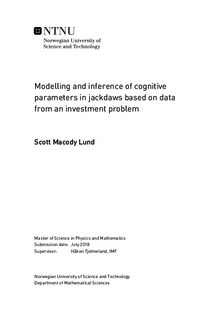Modelling and inference of cognitive parameters in jackdaws based on data from an investment problem
Master thesis
Permanent lenke
http://hdl.handle.net/11250/2566720Utgivelsesdato
2018Metadata
Vis full innførselSamlinger
Sammendrag
Studying animal cognition is both interesting on its own, and because it can improve our understanding of human cognition. It can, for example, reveal when certain cognitive treats were developed in evolution. In this thesis, we consider an investment problem from a behavioural experiment on two jackdaws. The experiment was performed in 2012 by two neuroscientists at NTNU.
In the experiment, the birds are rewarded if they invest enough in the correct situations. The investments are measured by the amount of pecking the birds perform on a computer screen. The birds must evaluate how probable they believe it is that they will be rewarded and how much pecking they want to do. We describe the experiment and develop a statistical model for the situation, including the participants' cognition. Furthermore, we present relevant theory and methods and discuss how they apply to our model. We use these methods to estimate the cognitive parameters and fit our model to the observed data. From the fitted model, new data is simulated and compared to the observed data. Several aspects of the birds' behaviour are found to be present in the simulated data.
There are however some patterns in the birds' behaviour which is not found in the simulations. For one of the birds, a hypothesis test results in the model being rejected at a significance level of 0.05. Based on this, we suggest changes in the model assumptions for that bird. Throughout the analysis, we compare the birds to each other. At one point, we see a surprisingly big difference between them. The data suggest that one bird has much more belief in its own memory when it is hungry. The other bird shows no such effect. Finally, we discuss what could be interesting to consider for further work, including further investigation of whether the birds do respond differently to being hungry.
